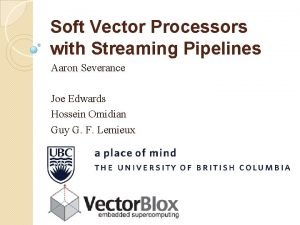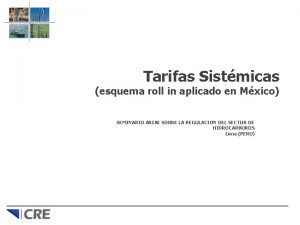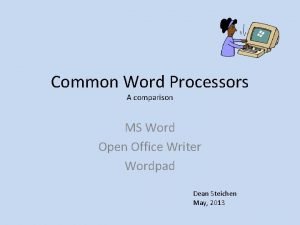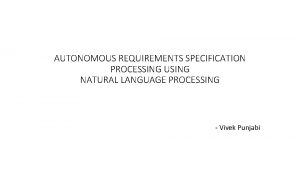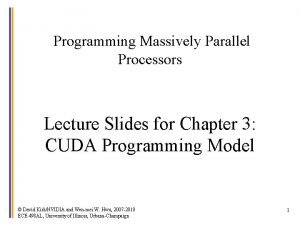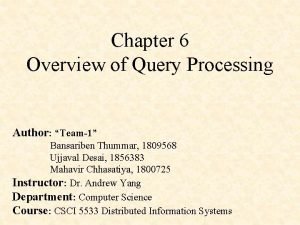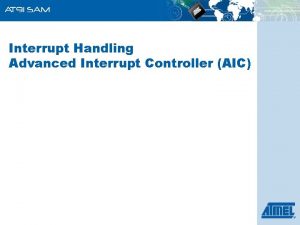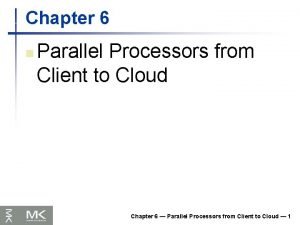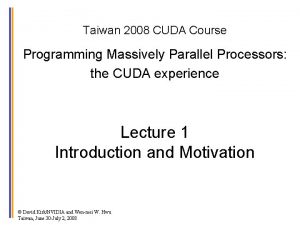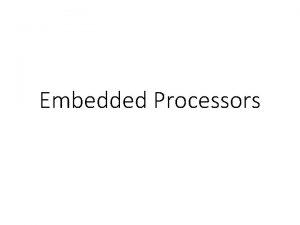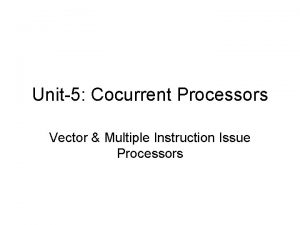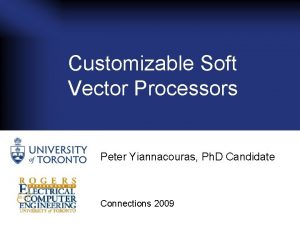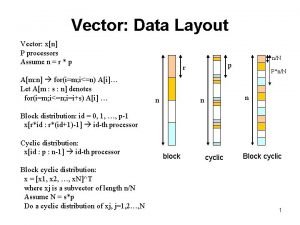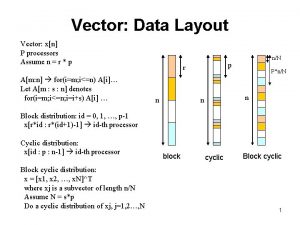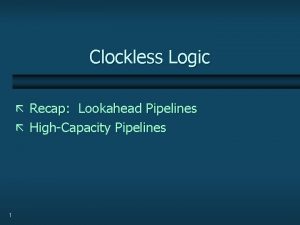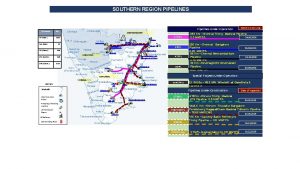Soft Vector Processors with Streaming Pipelines Aaron Severance





















- Slides: 21

Soft Vector Processors with Streaming Pipelines Aaron Severance Joe Edwards Hossein Omidian Guy G. F. Lemieux

Motivation �Data parallel problems on FPGAs ◦ ESL? ◦ Overlays? ◦ Processors? 2

Example: N-Body Problem �O(N 2) force calculation ◦ Streaming Pipeline (custom vector instruction) �O(N) housekeeping ◦ Overlay (soft vector processor) �O(1) control ◦ Processor (ARM or soft-core) 3

Soft Vector Processor (SVP) 4

Vector. Blox MXP � 1 to 128 parallel vector lanes (4 shown) 5

MXP Datapath 6

Custom Vector Instructions (CVIs) �Simple CVI parallel scalar CIs 7

CVI Complications (1) �CVIs can be big ◦ e. g. square root, floating point ◦ Bigger than entire integer ALU �Make them cheaper ◦ Don’t replicate for every lane ◦ Reuse existing alignment networks �No additional costs, buffering 8

Cheap Heterogeneous Lanes 9

CVI Complications (2) �CVIs can be deep ◦ e. g. FP addition >> depth than MXP pipeline �Execute stage is 3 cycles, stall-free �CVI pipeline must ‘warm up’ ◦ Don’t writeback until valid data appears ◦ Best if vector length >> CVI depth 10

Multiple Operand CVIs � 2 D N-body problem: 3 inputs, 2 outputs 11

4 Input, 2 Output CVI Option 1: Spatially Interleaved �Easy for interleaved (Array-of-Struct) data ◦ But vector data is normally contiguous (So. A) 12

4 Input, 2 Output CVI Option 2: Time Interleaved �Alternate operands every cycle ◦ Data is valid every 2 cycles 13

4 Input, 2 Output CVI Option 2 with Funnel Adapters �Multiplex 2 CVI lanes to one pipeline ◦ Use existing 2 D/3 D instructions to dispatch 14

Building CVIs �We created CVIs via 3 methods: 1. RTL 2. Altera’s DSP Builder 3. Synthesis from C (custom LLVM solution) 15

Altera’s DSP Builder �Fixed or Floating-Point Pipelines ◦ Automatic pipelining given target �Adapters provided to MXP CVI interface 16

Synthesis From C (using LLVM) for( int glane = 0 ; glane < CVI_LANES ; glane++ ) { f 16_t gmm = f 16_mul( ref_gm, m[glane] ); f 16_t dx = f 16_sub( ref_px, px[glane] ); f 16_t dy = f 16_sub( ref_py, py[glane] ); f 16_t dx 2 = f 16_mul(dx, dx); f 16_t dy 2 = f 16_mul(dy, dy); f 16_t r 2 = f 16_add(dx 2, dy 2); f 16_t CVI_LANES r = f 16_sqrt(r 2); #define 8 /* number of physical lanes */ f 16_t int 32_t rr = f 16_div(F 16(1. 0), r); typedef f 16_t gmm_rr = f 16_mul(rr, gmm_68); f 16_t ref_px, ref_py, ref_gm; f 16_t gmm_rr 2 = f 16_mul(rr, gmm_rr); f 16_t px[CVI_LANES], py[CVI_LANES], m[CVI_LANES]; f 16_t gmm_rr 3 = f 16_mul(rr, gmm_rr 2); f 16_t result_x[CVI_LANES], result_y[CVI_LANES]; f 16_t dfx = f 16_mul(dx, gmm_rr 3); f 16_t dfy = f 16_mul(dy, gmm_rr 3); void force_calc() { f 16_t result_x = f 16_add(result_x[glane], dfx); f 16_t for( int result_y glane = 0=; f 16_add(result_y[glane], dfy); glane < CVI_LANES ; glane++ ) { result_x[glane] //CVI code here= result_x; } result_y[glane] = result_y; }} �CVI templates provided �Restricted C subset Verilog ◦ Can run on scalar core for easy debugging 17

N-Body Performance 18

Performance/Area SVP Configuration V 32, 16 physical pipelines MXP Speedup/ALM Relative to Nios II/f 1. 1 MXP + DIV/SQRT 19. 7 MXP + N-Body (floating-point) 68. 7 MXP + N-Body (fixed-point) 116. 0 19

Conclusions �CVIs can incorporate streaming pipelines ◦ SVP handles control, light data processing ◦ Deep pipelines exploit FPGA strengths �Efficient, lightweight interfaces ◦ Including multiple input & output operands �Multiple ways to build and integrate 20

Thank You 21
 Severance streaming
Severance streaming Updm pipelines
Updm pipelines Westwood pipelines
Westwood pipelines Edge to core to cloud
Edge to core to cloud Ammonia pipelines
Ammonia pipelines Pipelines
Pipelines Questar pipelines
Questar pipelines Ece 526
Ece 526 Comparison of word processors
Comparison of word processors Language and processors for requirement
Language and processors for requirement Non linear pipeline processor
Non linear pipeline processor David kirk nvidia
David kirk nvidia Digital camera processors
Digital camera processors Macro call is handled in this pass of macro processor
Macro call is handled in this pass of macro processor Characterization of query processors
Characterization of query processors Networks and telecommunications presentation
Networks and telecommunications presentation Interrupt handling in arm processors
Interrupt handling in arm processors Gas processors association
Gas processors association Advantages and disadvantages of intel processors
Advantages and disadvantages of intel processors Difference between superscalar and vliw
Difference between superscalar and vliw Parallel processors from client to cloud
Parallel processors from client to cloud Programming massively parallel processors, kirk et al.
Programming massively parallel processors, kirk et al.
